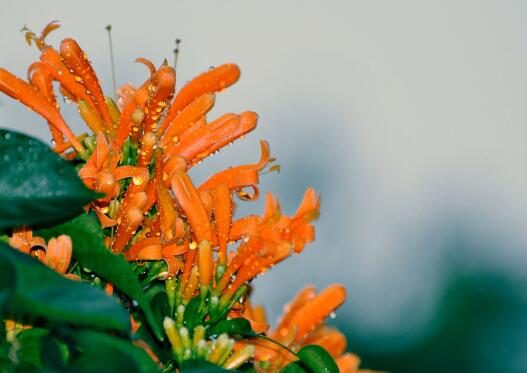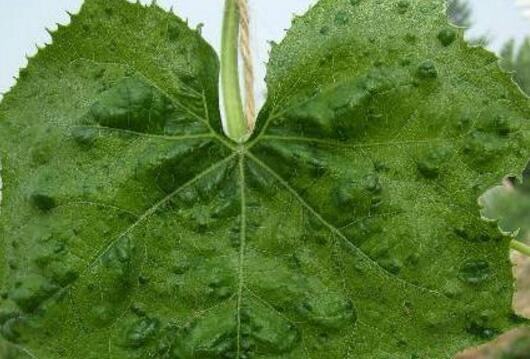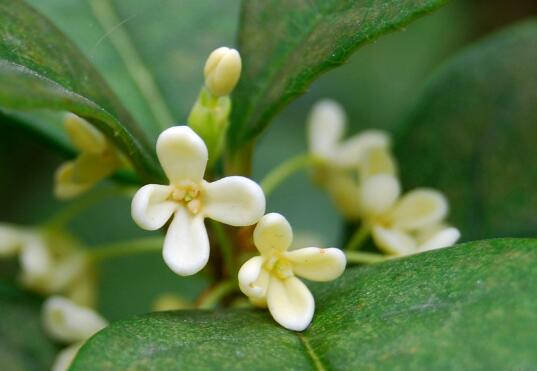Does firecracker flower grow insects? pest control of firecracker flower / 2 insect pests 2 diseases
In the process of firecracker flower growth, what people are most afraid of is the problems of diseases and insect pests, which do great harm to the plant, not only affect the ornamental, but also cause the plant wilt if not dealt with in time. About firecrackers, flowers and worms? How to control the diseases and insect pests of firecrackers? Next, the editor will take you to learn about it.
Firecracker flowers grow worms

With regard to the question of firecrackers growing insects, the answer is yes. In the process of firecracker flower growth, if it is not properly maintained, it is not prone to whitefly and shell insects. In addition, there are some diseases. As for how to solve this kind of problem, it is described in detail below. Let's take a look at it.
II. Control of diseases and insect pests of firecrackers
Insect pest
1. Shell worm
Among the diseases and insect pests of firecrackers, the shell insect is one of the most harmful, which mainly harms the leaves, branches and fruits of firecrackers, resulting in their leaves gradually yellowing and shedding, and finally leading to plant death.
Control method: in the control of this pest, we can use 1000 times of imidophos to directly spray it.
two。 Whitefly
Whitefly is a very small pest, and the largest one is no more than 3mm. This pest mainly feeds on the juice of firecrackers, which will gradually ingest, resulting in a large loss of nutrients and finally wilting, which is one of the most harmful diseases and insect pests of firecrackers.
Control method: the reproductive ability of this pest is very strong, so we must deal with it as soon as possible. We can use 1200 times of omethoate EC to spray it.
Disease
1. Leaf spot disease
Leaf spot disease is a relatively high incidence of diseases and insect pests in firecrackers, and its high incidence period is in the spring and autumn every year, so in this period of time, we must pay special attention to the leaf spot disease. Many brown disease spots will appear on the leaves of firecracker flowers, and will gradually spread with the passage of time, resulting in the gradual death of the plant.
Prevention and control methods: in the prevention and control of leaf spot disease, we can use 80% mancozeb 400-600 times to spray the diseased plants, usually once every 7-10 days, and basically recover after 2-3 times.
two。 Powdery mildew
Among the diseases and insect pests of firecrackers, powdery mildew is a common disease. during the disease, many dusty spots will appear on the leaves of firecrackers, which will gradually cover the leaves with the passage of time. as a result, it can not carry out photosynthesis and gradually wither.
Prevention and treatment: in the prevention and control of powdery mildew, we can use 1500 times of carbendazim wettable powder to spray firecrackers, usually once in 12-15 days, 2-3 times can be cured.
What are the common diseases and insect pests of a gentleman? to make a gentleman's disease and insect pest control / 2 insect pests 3 diseases
In the process of making a gentleman's growth, the last thing we want to encounter is diseases and insect pests. This kind of problem is extremely harmful to the plant, and it will do great harm to the plant if it is not dealt with in time. So what are the common diseases and insect pests that make a gentleman? What do you need to do to make a gentleman's disease and pest control? Next, the editor will take you to learn about it.
First, what are the common diseases and insect pests of a gentleman, aphids / leaf spot disease
When it comes to the common diseases and insect pests of a gentleman, in fact, there are mainly aphids, scale insects, anthrax, leaf spot and powdery mildew. This species of diseases and insect pests do great harm to plants, so they must be dealt with in time when they are found. The specific treatment methods in the following, let's take a look at it.
Second, to make a gentleman's pest control (pest control)
1. Aphids
Aphids are a kind of pest that exists in many plants, and the gentleman is no exception. It is a plant-eating insect, which mainly harms the leaves and stems of the gentleman. It will gradually absorb the juice, thus causing a large loss of nutrients in the plant. With the passage of time, it will also cause the plant to gradually wither and die.
Control method: when we deal with this kind of diseases and insect pests that make a gentleman, if the number of pests is relatively small, we can prune the damaged branches and then disinfect the plants. If the quantity is large, we can directly use 3000 times of 50% aldicarb wettable powder to spray directly.
two。 Scale insect
Scale insect is a kind of harmful pest, which mainly threatens the leaves, branches and fruits of gentlemen. It will cause yellowing of leaves, withering of branches, decline of tree potential and so on, as well as coal fouling disease.
Control method: for this kind of disease and insect pest that makes a gentleman, we can spray it with 1000-1500 times of insecticide mixed with 40.7% Lesbon EC and 80% dichlorvos EC in the ratio of 1 to 1.
Third, make the gentleman's disease and insect pest control (disease)
1. Anthrax
Anthracnose is the main threat to the leaves of the gentleman, many brown disease spots will appear on the leaves at the initial stage of the disease, and with the passage of time, the disease spots will gradually expand and occupy the general area of the leaflets, so that the plants can not carry out photosynthesis and gradually wither and yellow, and the leaves will gradually fall off.
Control method: in the prevention and control of this gentleman's disease and insect pest, we can use 1000 times of methyl topiramate wettable powder to spray the diseased plant, usually once every 7-10 days, 2-3 times can be cured.
two。 Leaf spot disease
Leaf spot is a disease caused by fungi, its high incidence period in the spring and autumn every day, so in this period of time we must pay special attention. When the gentleman appears this disease, there will be many brown round disease spots on the leaves, and with the passage of time will gradually spread to the petiole and stem, and finally lead to plant atrophy and death.
Prevention and control method: when we deal with this kind of gentleman's disease and insect pest, we can use 20% silazole ·prochloraz 1000 times liquid to spray and control it, usually once a week or so, and then it can be cured after 1-2 times.
3. Powdery mildew
Among the diseases and insect pests of the gentleman, powdery mildew is a relatively common disease. When the disease occurs, many dust-like spots will appear on the leaves of the gentleman, which will gradually cover the leaf surface over time, resulting in its inability to carry out photosynthesis and gradually wither.
Prevention and control methods: in view of this kind of diseases and insect pests, we can use 1500 times of carbendazim wettable powder to spray firecrackers, which is usually sprayed once every 12-15 days, and can be cured 2-3 times.
Prevention and control of common diseases and insect pests in firecrackers
Firecracker flower, alias: yellow eel vine; Latin name: Pyrostegia venusta (Ker-Gawl.) Miers Liriodendron and firecracker vines with 3-forked filamentous tendrils. Leaves opposite; stamens inserted in middle of Corolla tube, filaments filiform, anthers diverging. Ovary cylindrical, densely pilose, style thin, stigma ligulate flattened, style and filaments protruding from Corolla tube. Fruit petal leathery, navicular, with many rows of seeds, seeds winged, thin membranous. It has a long florescence and is native to South America and Brazil. It has been widely cultivated as a garden ornamental rattan plant in tropical Asia. More planted around the garden buildings, climbing in the Arbor, early summer red and orange flowers in clusters, shaped like firecrackers, so it is known as firecrackers.
Firecracker flowers, vines, with 3-forked filamentous tendrils. Leaves opposite; leaflets 2-3, ovate, apex acuminate, base suborbicular, 4-10 cm long, 3-5 cm wide, upper and lower surfaces glabrous, with tiny scattered glandular cavities below, entire; leaf rachis ca. 2 cm long; petiolules 5-20 mm long.
Panicles inserted at top of lateral branches, ca. 10-12 cm. Calyx campanulate, 5-denticulate. Corolla tubular, with a hair ring in the middle of the inner face, base contracted, orange-red, lobes 5, long oval, valvate arrangement of buds, flowers reflexed after opening, margin white pubescent. Stamens inserted in middle of Corolla tube, filaments filiform, anthers diverging. Ovary cylindrical, densely pilose, style thin, stigma ligulate flattened, style and filaments protruding from Corolla tube.
Fruit petal leathery, navicular, with many rows of seeds, seeds winged, thin membranous. The flowering period is long, which can be as long as half a year in Xishuangbanna Tropical Botanical Garden, Yunnan Province, usually from January to June.
Rare leaf spot and powdery mildew of firecrackers were sprayed with 1500 times of carbendazim wettable powder.
Firecracker flower pests include whitefly and shell insects, which can be sprayed with 1200 times omethoate EC.
- Prev

High humidity / lack of fertilizer and water is the main cause of pest control of Prunus mume.
Even in the wild, the five-colored plum can grow normally, so its adaptability is beyond doubt, but no matter how strong the adaptability is, diseases and insect pests will inevitably occur because of the improper culture methods of the five-colored plum. It will cause the five-colored plum to grow weak and not blossom, so it must be prevented and controlled in time.
- Next

The difference between Cinnamomum chinense and Cinnamomum chinense is different in body shape / shape / breeding method.
Japanese cinnamon and four seasons cinnamon are two different plants, four seasons cinnamon belongs to metaphora, while Japanese incense belongs to transition flower order, but because their shapes are similar, they are often confused by people. In fact, there are still many differences between the two. What are the differences between cinnamon and four seasons?
Related
- Fuxing push coffee new agricultural production and marketing class: lack of small-scale processing plants
- Jujube rice field leisure farm deep ploughing Yilan for five years to create a space for organic food and play
- Nongyu Farm-A trial of organic papaya for brave women with advanced technology
- Four points for attention in the prevention and control of diseases and insect pests of edible fungi
- How to add nutrient solution to Edible Fungi
- Is there any good way to control edible fungus mites?
- Open Inoculation Technology of Edible Fungi
- Is there any clever way to use fertilizer for edible fungus in winter?
- What agents are used to kill the pathogens of edible fungi in the mushroom shed?
- Rapid drying of Edible Fungi

